Rockfalls pose a significant problem in geotechnical engineering and construction. These natural events can lead to serious property damage, injuries, and even loss of life. It is crucial to implement effective rockfall mitigation measures to prevent such incidents from occurring.
To minimize the risk of rockfalls, various solutions have been developed. These solutions involve the implementation of engineering techniques that aim to stabilize slopes, reinforce rock masses, and redirect falling rocks away from vulnerable areas. By utilizing these effective mitigation measures, the potential impact of rockfalls can be greatly reduced, ensuring the safety and stability of infrastructure and surrounding environments.
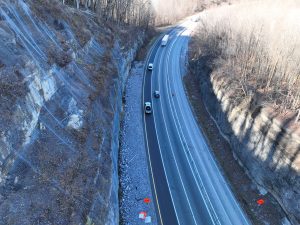
One commonly used technique is the installation of pinned mesh. This involves securing wire mesh panels to rock faces using rock bolts or other anchoring systems. Pinned mesh provides enhanced stability and resistance against rockfall events by reinforcing the structural integrity of the rock surface.
Draped mesh takes the wire mesh technique a step further. It is installed in a draped or draped-like configuration over a rock face, allowing for controlled containment of loose rocks. Draped mesh helps to reduce the risk of rockfall events by securely holding rocks in place.
Cable net mesh is a robust control measure that utilizes high-tensile steel cables to form a net-like structure. This mesh is installed on rock slopes to provide a strong and flexible barrier against falling rocks. Cable net mesh is designed to absorb and distribute the energy of rockfall impacts, minimizing the potential damage to protected areas.
Anchored mesh combines the use of wire mesh with additional anchoring techniques. It involves securing the wire mesh panels to the rock face using rock bolts or other anchoring
Rockfall netting is a specialized type of mesh that is specifically designed to withstand the impact of falling rocks. It is made of high-strength materials and is capable of absorbing and dissipating the energy generated by rockfall events. Rockfall netting provides reliable protection against rockfall hazards.
In some cases, boulder breaking techniques are employed to mitigate the risks associated with large boulders. This involves the controlled breaking or fragmentation of boulders using specialized equipment and techniques. By reducing the size and potential impact of the boulders, boulder breaking makes them easier to manage and remove.
Active netting systems are pivotal—they shield slopes against potential rockfalls, enhancing the stability of affected terrains.
Active netting combines high tensile strength with flexibility, mitigating rockfall risk and safeguarding lives and infrastructure below.
It is essential to anchor these systems securely, as they must withstand dynamic loads and arrest falling debris, conforming to the rock surface, and often require periodic maintenance.
Properly installed, active netting acts as a first line of defense—preventing detachment and descent of rocks, ensuring a safer landscape for communities and infrastructure adjacent to high-risk slopes.
Passive barriers stand vigilant, a silent guardian against rockfall.
Engineered to embody resilience and strength, passive rockfall barriers provide a critical buffer zone. They can capture and hold falling debris, preventing it from reaching valuable infrastructure or populated areas, and are, therefore, an indispensable component in rockfall mitigation strategies. Passive systems are not dependent on the movement of the rockfall to activate.
Their impact is localized, affecting only the boulders they intercept.
In the domain of effectiveness, materials matter - from wire mesh panels to high-strength steel posts that frame passive barriers. These systems must be meticulously composed to withstand the rigorous demands of geological threats, embodying the pinnacle of rock engineering innovation.
Passive barriers form the last line of defense, often positioned after active systems have served their purpose. They are particularly crucial in areas where rockfall incidents are infrequent but potentially catastrophic, demanding the most reliable forms of protection available in the industry.
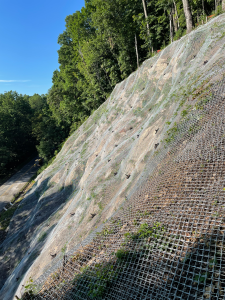
Adherence to the rock surface is essential for mesh effectiveness. Installation typically requires drilling into rock faces and inserting anchors, which hold the mesh in place. These anchoring points distribute forces evenly, improving the system's protective capacity.
The mesh itself, often constructed from high-tensile steel wire, acts as a shield against rock detachments, cascading to the foot of the slope. In more complex terrains, advanced installation techniques, including the use of a spider excavator, enable precision and adaptability amidst challenging landscape features.
Given the diversity of geological conditions, anchored mesh is tailored to site specifics. This includes consideration of slope angle, rock type, and anticipated loading from potential rockfalls. Incorporating design criteria that reflect the complexity of natural environments ensures that anchored mesh systems remain at the forefront of passive rockfall protection, ensuring safety and resilience in our ever-developing world.
Rockfall containment systems comprise engineering controls designed to catch and retain falling rocks. Durability and robustness are crucial qualities for materials like rockfall barriers and netting systems, which must sustain the dynamic pressures from high-velocity rockfalls. These systems often include rings and cables that interconnect to form a flexible barrier, capable of absorbing and dissipating the kinetic energy of rockfalls, thereby averting potential damage.
Innovative solutions, such as telescopic posts and brake elements, have enhanced the adaptability of rockfall barriers. These designs allow for energy absorption from fallen rocks of varied sizes and can be strategically positioned to protect vulnerable infrastructure. The inclusion of spider excavators in challenging terrains facilitates the installation of these containment structures, empowering operators to reach inaccessible slopes while ensuring the safety and effectiveness of the rockfall mitigation system.
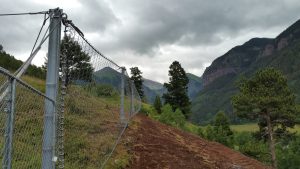
Catchment ditches act as passive collectors for detritus and errant boulders, mitigating the risk before reaching valued assets.
These engineered solutions must accommodate varying topographies and load demands, ensuring sufficient rockfall energy absorption. Design considerations include optimal fence heights, ditch dimensions, and the angle of the slope for effective containment.
Strategically placed catchment fences and ditches not only safeguard but also organize drainage, which is essential for long-term slope stability. Employing these measures necessitates expertise in geotechnical engineering and a comprehensive understanding of the site-specific rockfall dynamics, ensuring that the correct approaches are taken to manage the inherent risks.
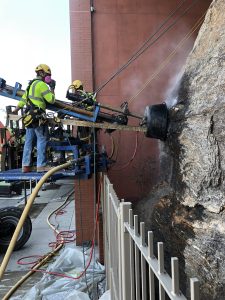
Properly anchored bolts are essential in mitigating rockfall risks, especially in steep terrain.
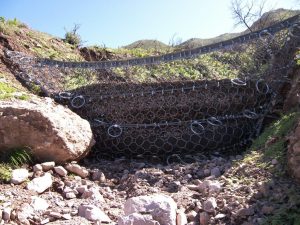
To further safeguard against these natural events, flexible debris flow nets and engineered channels are implemented to guide the flows along predetermined paths, minimizing potential damage. These measures must be complemented by regular maintenance and monitoring programs, ensuring that the mitigation infrastructure remains effective in the face of dynamic environmental conditions and ongoing erosion processes.
Deflection and diversion walls are pivotal in redirecting rockfall energy away from vulnerable assets.
These structures require detailed engineering and geotechnical analysis to ensure efficacy.
Proper maintenance is essential for sustaining the protective functions of these barriers over time.
Energy dissipation basins are engineered structures designed to absorb the kinetic energy from falling rocks, reducing potential damage to the infrastructure below. This controlled deceleration is achieved through basin geometry and the selection of energy-absorbing materials within the structure.
Constructed at the foot of a slope where rockfalls are likely, these basins form a critical part of a comprehensive rockfall mitigation strategy. They are specifically contoured to dissipate energy, acting like a cushion to slow down and halt the falling debris.
The basin's depth and inclination are meticulously calculated based on anticipated rockfall volumes and energies, ensuring maximized energy absorption. Materials such as riprap, engineered fill, or specially designed cellular confinement systems often line the basins to enhance this effect.
To prevent overflow and maintain effectiveness, drainage systems are usually integrated within these basins. Such provisions ensure that water does not compromise the physical integrity or the energy-dissipating efficiency of the basins.
When constructing energy dissipation basins, access to the site often requires the use of specialized equipment, like the spider excavator. This is due to its ability to navigate steep or uneven terrain with minimal environmental impact.
Finally, continued vigilance in the form of regular inspections and maintenance is paramount. This ensures that the basins' energy-absorbing capacities are not compromised by material displacement or basin deformation.
Mitigating the risks associated with rockfall events entails a combination of control and containment solutions tailored to the specific conditions of a site. Control measures, such as rock bolts, anchors, and mesh systems, are critical for stabilizing potential failure zones and securing loose rock. This proactive approach can dramatically reduce the occurrence of hazardous rockfalls.
Meanwhile, containment systems, including catch fences and barriers, are designed to intercept and retain falling debris, thereby protecting infrastructures and passageways below. In particularly steep terrains, the spider excavator stands out for its capability to perform scaling and steep slope drilling, vital for the preparation and maintenance of these remediation structures due to its exceptional maneuverability.
For debris flow mitigation, specially engineered channels and deflection walls direct the flow away from critical areas, minimizing the impact on nearby communities and infrastructure. It is the meticulous integration of these elements that forms a robust defense against the threats posed by rockfalls.
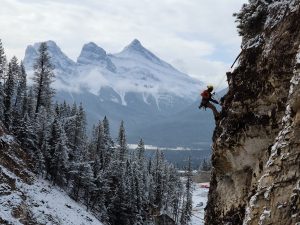
Manual scaling involves skilled technicians meticulously clearing dangerous debris from the slope using hand tools. Their expertise and careful approach are essential in ensuring the safety and integrity of the slope. On the other hand, mechanical scaling utilizes specialized equipment to efficiently remove loose rocks, enhancing the overall efficiency of the process.
Accessing steep and challenging terrains requires the expertise of rope access certified technicians. These professionals are trained to work at heights and can safely navigate difficult areas to perform scaling operations. Their knowledge and experience contribute to the effectiveness of rockfall mitigation efforts.
For more complex situations, blasting services may be necessary. Blasting techniques are employed to dislodge larger rock masses that cannot be removed through manual or mechanical scaling alone. These controlled explosions are carried out by trained professionals following strict safety protocols to ensure the desired results without compromising slope stability.
In addition to these methods, the spider excavator, with its versatile climbing ability, proves to be an invaluable asset in scaling operations. This unique piece of equipment enables access to areas that would otherwise be unreachable, especially on steep terrains. Its nimble arachnid-like movement combined with powerful excavation capabilities significantly enhances the efficiency and effectiveness of scaling efforts, particularly in remote and challenging environments.
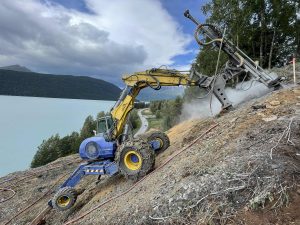
For steep slope drilling operations, a carefully orchestrated sequence of techniques is employed to ensure the stability of rock faces. Employing specialized drilling rigs, operators must contend with the mechanics of gravity, vibrations, and the potential for sliding or rock fall during the drilling process. Effective anchoring systems, such as tiebacks or soil nails, are installed to provide immediate reinforcement, necessitating a delicate balance between the drilling process and the slope's natural composition.
In navigating these precarious environments, the spider excavator emerges as a critical piece of equipment. Thanks to its adaptive undercarriage and advanced hydraulic capabilities, the spider excavator can maneuver with astonishing precision across steep gradients. This agility allows for the safe positioning of drilling rigs and the execution of soil nailing, anchor installation, and other stabilization measures without disturbing the existing landscape more than necessary.
Crucially, the role of steep slope drilling operations extends beyond the establishment of immediate stabilization measures. It involves detailed planning and the use of technology to forecast the response of the slope to interventions. Advanced geotechnical modeling software, paired with ongoing monitoring, ensures that the executed drilling and stabilization work remain effective over time. The spider excavator, playing a central role in this process, facilitates not just the execution of complex drilling tasks but also the deployment of instruments and technologies required for long-term slope performance assessment.
Preventing rockfalls is a complex task that requires the expertise of geotechnical engineers and construction professionals. By employing a combination of control and containment solutions, such as rock bolts, barriers, and mesh systems, we can stabilize potential failure zones and intercept falling debris. Additionally, the use of innovative equipment like the spider excavator allows for efficient scaling and steep slope drilling operations in challenging terrains. With these effective rockfall mitigation strategies in place, we can protect lives, infrastructure, and communities from the unpredictable forces of nature, ensuring safety and resilience in our communities.